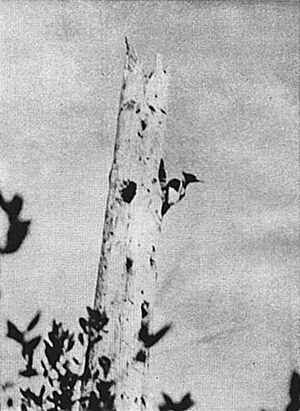Cuban ivory-billed woodpecker facts for kids
Quick facts for kids Campephilus principalis bairdii |
|
|---|---|
 |
|
| A male Cuban ivory-billed woodpecker photographed by John Dennis | |
| Scientific classification |
|
| Kingdom: | Animalia |
| Phylum: | Chordata |
| Class: | Aves |
| Order: | Piciformes |
| Family: | Picidae |
| Genus: | Campephilus |
| Species: | |
| Subspecies: |
C. p. bairdii
|
| Trinomial name | |
| Campephilus principalis bairdii (Cassin, 1863)
|
|
The Cuban ivory-billed woodpecker (Spanish: carpintero real) (Campephilus principalis bairdii) is a special type of subspecies of the ivory-billed woodpecker. It used to live only in Cuba. Scientists first thought it was its own unique species. Later, they decided it was a subspecies of the American ivory-billed woodpecker. However, some newer studies suggest it might be different enough to be called its own species again.
Sadly, no one has officially seen this bird since 1987. Most people believe it is now extinct, meaning it has completely died out. But a very small chance remains that a few might still be alive.
Contents
About the Cuban Ivory-billed Woodpecker
What it Looks Like and Its Family Tree
The Cuban ivory-billed woodpecker looks a lot like its American cousin. But it is a bit smaller. It has black feathers on the front of its head that are longer than the bright red feathers behind them. It also has a white stripe on its neck that goes all the way to its beak.
A scientist named John Cassin first described this bird in 1863. He thought it was a separate species, calling it C. bairdii. Later, it was grouped as a subspecies of the American ivory-billed woodpecker, C. principalis.
More recently, some scientists have looked at the bird's DNA. They found that the Cuban and American ivory-billed woodpeckers are quite different. This suggests they might be separate species after all. They are also related to the imperial woodpecker, forming a group of large woodpeckers in North America.
The first detailed notes about this bird's life and where it lived were written in 1893. This was done by Juan Gundlach in his book about Cuban birds. In Cuba, people often called it carpintero real, which means "royal woodpecker."
Where the Cuban Woodpecker Lived
Its Home in the Forests
Just like the American ivory-billed woodpecker, the Cuban ivory-bill loved old-growth forests. These are very old forests with many large, mature trees. These forests had lots of dead or dying trees. These trees were important because they were full of beetle larvae, which were the main food for the woodpeckers.
By the early 1900s, most of Cuba's lowland forests were cut down. This meant the woodpecker had to move to the Cuban pine forests. These were mountain forests with special pine trees like Pinus cubensis and Pinus tropicalis. These forests were mostly in the northeastern part of the island.
Originally, the bird lived in places like the Organ Mountains and near the Hanabana River.
How the Cuban Woodpecker Behaved
Daily Life and Habits
Scientists don't have many detailed stories about how these birds lived in the wild. An ornithologist (bird scientist) named John Dennis found a few birds in 1948. He watched them eat and do other things. He noticed they spent a lot of time cleaning their feathers.
He also observed that the birds were not very shy once they got used to him. They sometimes seemed quite relaxed. He even saw a male woodpecker quickly chase away a kestrel (a type of hawk) that came too close to its nest.
The Cuban ivory-billed woodpecker usually had its breeding season from March to June. Scientists think these woodpeckers might have lived in small groups. This would help them find and use their food source, which was often found in patches. The imperial woodpecker, another large species, was sometimes seen in groups of eight or more.
Status of the Cuban Woodpecker
Why It Became So Rare
Even though it was once common, the Cuban ivory-billed woodpecker was already very rare by the late 1940s. John Dennis found a small group in a forest that had already been cut for timber. In 1956, George Lamb found six areas where the birds still lived. He suggested a plan to protect them. However, the Cuban Revolution happened in 1959, which changed things.
The last time anyone officially confirmed seeing a Cuban ivory-billed woodpecker was in 1987. A female bird was seen in the mountains of eastern Cuba. This sighting came after a few observations of both male and female birds in 1986-87 by a team of bird experts.
The Cuban government immediately protected the area where the birds were seen. But searches in 1991 and 1993 did not find any more signs of the bird. It became clear that the birds seen in 1986-87 were already in a very bad situation. Because of this, it is believed the Cuban ivory-bill became extinct around 1990. The protected area is now part of Alejandro de Humboldt National Park.
The IUCN Red List, which tracks endangered species, notes that calls were reportedly heard in 1998. These calls were in the highest parts of the Sierra Maestra mountains. But a search after that did not find any birds or good places for them to live. Still, it is considered a very small possibility that some individuals might still be alive. This is because about 80% of suitable habitats in Cuba have not yet been fully explored.

